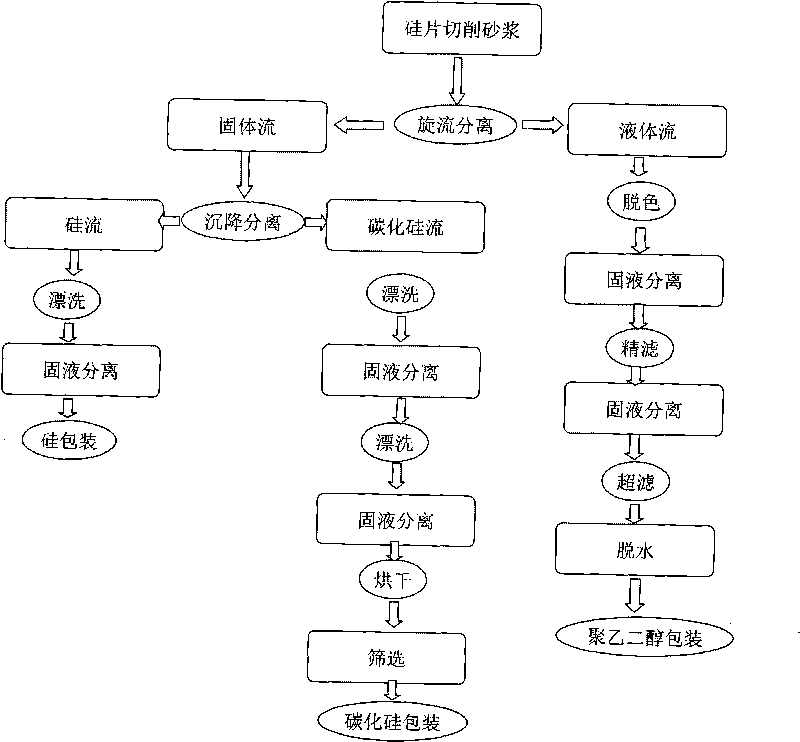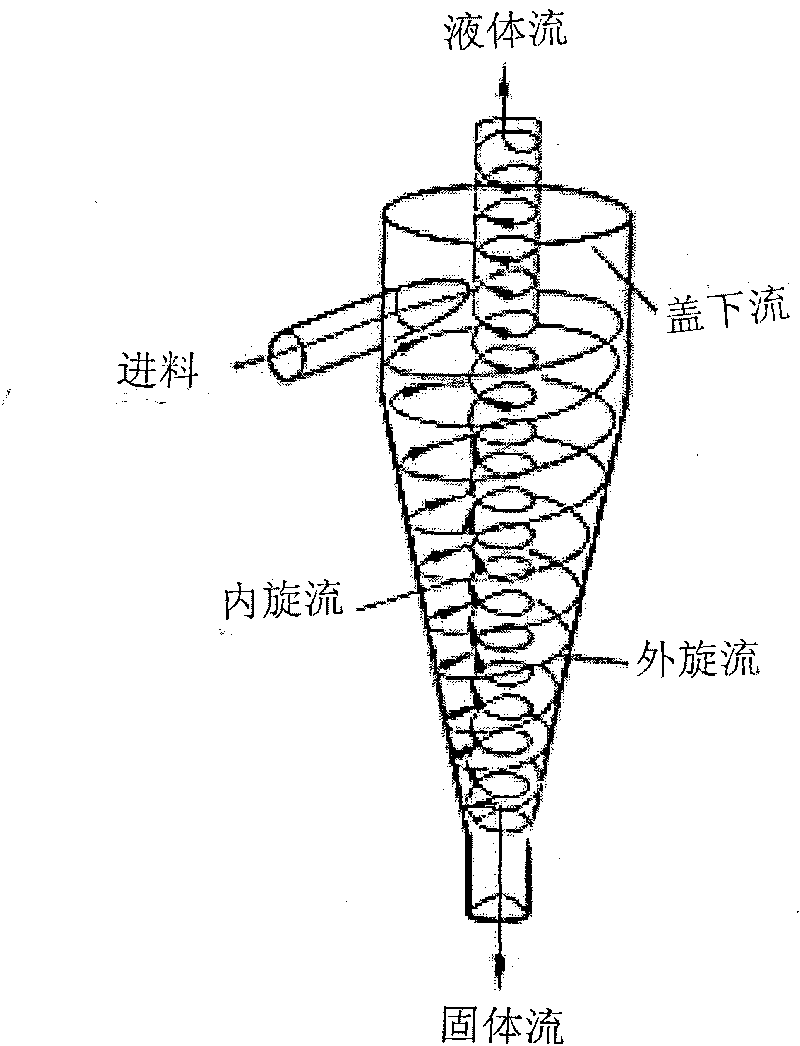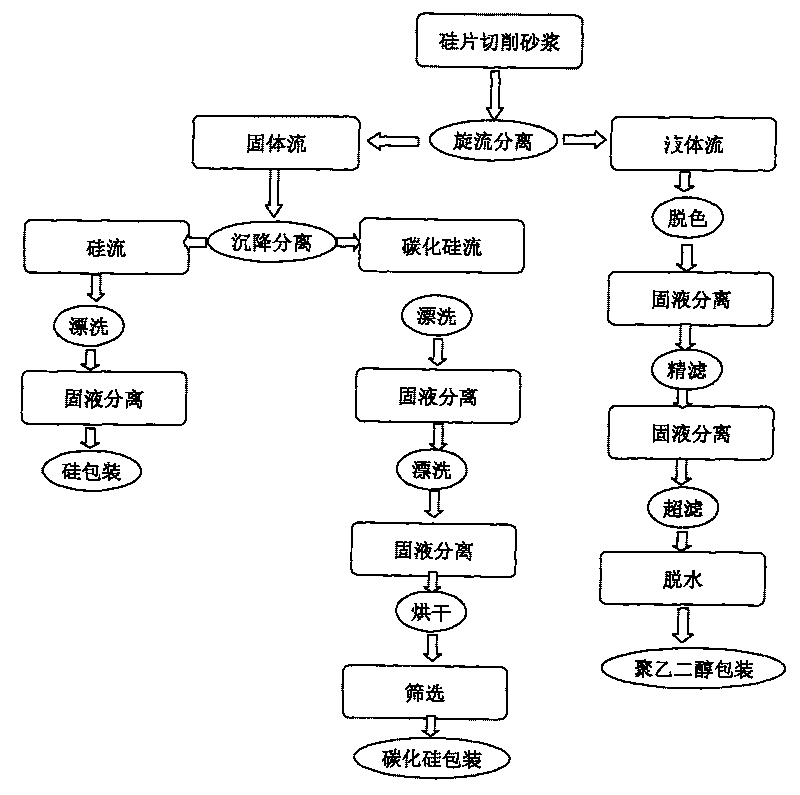Method for extracting silicon, silicon carbide and polyethylene glycol from silicon wafer slicing slurry
A polyethylene glycol, silicon carbide technology, applied in chemical instruments and methods, silicon compounds, inorganic chemistry, etc., can solve problems such as environmental pollution, achieve considerable economic benefits, improve use efficiency, and avoid pollution.
- Summary
- Abstract
- Description
- Claims
- Application Information
AI Technical Summary
Problems solved by technology
Method used
Image
Examples
Embodiment 1
[0047] Weigh 1000g of silicon chip cutting mortar, stir evenly with a stirrer, and control the temperature at 25-60°C. Injected into a cyclone separator and separated at a pressure of 2 bar to obtain a 650g solid stream and a 350g liquid stream. After adding water, the solid flow enters the sedimentation separator, pressurizes to 3 bar, and works for 6 hours to obtain silicon cake and silicon carbide. Add water equivalent to 3 times the weight of the silicon cake into the silicon cake, filter through a microporous filter with a pore size of 1-3 μm, and maintain a pressure of 0.1-2 bar during filtration to obtain a finished silicon material. Add 600g of water to the silicon carbide, and carry out solid-liquid separation through a plate-and-frame filter press, add 1000g of water at 30°C to the obtained filter cake, stir for 1 hour, and pour it into a ceramic vacuum filter, and filter the filter cake Bake in an oven at 100°C for 5 hours to make the moisture content of silicon ca...
Embodiment 2
[0049] Weigh 2000g of silicon chip cutting mortar, stir evenly with a stirrer, and control the temperature at 25-60°C. Put into the cyclone separator, separate under the pressure of 1.8bar, obtain 1300g solid flow, 700g liquid flow. After adding water, the solid flow enters the sedimentation separator, pressurizes to 2.5 bar, and works for 7 hours to obtain silicon cake and silicon carbide. Add 1200g of water to the silicon cake, filter through a microporous filter with a pore size of 1-3μm, and maintain a pressure of 0.1-2bar during filtration to obtain the finished silicon material. Add 1500g of water to the silicon carbide, and pass through a plate and frame filter press for solidification Liquid separation, add 2000g of water at 30°C to the obtained filter cake, stir for 1.5 hours, put it into a ceramic vacuum filter, and put the filtered filter cake into a 110°C oven to bake for 3 hours, so that the moisture content of silicon carbide is lower than 0.1%. , cooled, and si...
Embodiment 3
[0051] Weigh 3000g of silicon chip cutting mortar, stir evenly with a stirrer, and control the temperature at 25-60°C. Put into a cyclone separator and separate under 3bar pressure to obtain 1950g solid flow and 1050g liquid flow. After adding water, the solid stream enters the sedimentation separator, pressurizes to 2 bar, and works for 3 hours to obtain silicon cake and silicon carbide. Add 1000g of water to the silicon cake, filter through a microporous filter with a pore size of 1-3μm, and maintain a pressure of 0.1-2bar during filtration to obtain the finished silicon material. Add 1500g of water to the silicon carbide, and pass through a plate and frame filter press for solidification Liquid separation, the obtained filter cake is added with 3000g of water at 35°C, stirred for 0.5 hours, put into a ceramic vacuum filter, and the filtered filter cake is baked in a 95°C oven for 6.5 hours, cooled, and sieved through a 90um vibrating sieve. After granulation, the finished ...
PUM
| Property | Measurement | Unit |
|---|---|---|
| microhardness | aaaaa | aaaaa |
Abstract
Description
Claims
Application Information
 Login to View More
Login to View More - R&D
- Intellectual Property
- Life Sciences
- Materials
- Tech Scout
- Unparalleled Data Quality
- Higher Quality Content
- 60% Fewer Hallucinations
Browse by: Latest US Patents, China's latest patents, Technical Efficacy Thesaurus, Application Domain, Technology Topic, Popular Technical Reports.
© 2025 PatSnap. All rights reserved.Legal|Privacy policy|Modern Slavery Act Transparency Statement|Sitemap|About US| Contact US: help@patsnap.com



